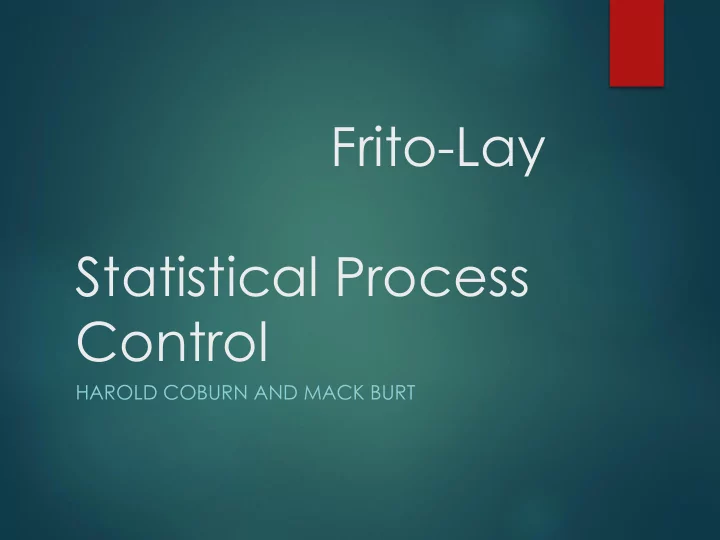

Frito-Lay Statistical Process Control HAROLD COBURN AND MACK BURT
Statistical Process Control The Application of statistical Techniques to control production process. Acceptance sampling is used to determine acceptance or rejection by evaluating a sample. S.P.C is widely used to ensure process meets standards. All processes are subject to a certain degree of variability.
Natural Variations Affect almost every production process and are to be expected. Are many sources of variation that occur within a process that is in statistical control. When grouped together they form a pattern described as distribution. When normal the are characterized by two parameters. Mean µ-The measure of central tendency. Standard deviation Ơ - The measure of dispersion.
Assignable Variations Can be traced to a specific reason. Factors such as machine wear, misadjusted equipment, fatigued or untrained workers or new batches of raw material. Assignable and natural variations distinguish two task for operation managers. Task 1 is ensuring that the process can operate under control. Task 2 identify and eliminate assignable variations.
Samples And Charts Major role in SPC. Proper sampling can allow you to discover any issue that are hidden. Charts are you used to visually see the whether or not the product exist between the control parameters.
X-Chart X chart monitors the arithmetic means of successive samples of constant size, n. This type of control chart is used for characteristics that can be measured on a continuous scale, such as weight, temperature, thickness etc. For example, one might take a sample of 5 shafts from production every hour, measure the diameter of each, and then plot, for each sample, the average of the five diameter values on the chart.
R-chart It is important to remember the two uses of an R control chart. One is to monitor the variability of product (combined with the measurement variation) and the other is to study the measuring variability by itself, thereby being able to discover how much of the original variability was due to product.
Excercise Using the variables for an x chart fill out the worksheet
Attribute Control Charts Chief way to control attributes (good or bad) Used for sampling attributes, classified as defective or non-defective Percent defective – p chart Number defective – c chart
Attribute Control Charts
Attribute Control Charts Upper Limits Control = p + z ợ p Lower Limits Control = p - z ợ p P = mean fraction defective in samples Z = number of standard deviations Ợ p = standard deviation of the sampling distribution
Poisson Probability Distribution Variance equal to its mean Basis for c charts C is number of defects per unit Standard deviation is equal to the square root of c Control limits = c +- 3 (square root of c)
C Chart Middle line is the target for quality
Managerial Issues Managers must select points in process that need SPC (Statistical Process Control) Must decide whether variable or attribute charts are appropriate Company must set clear SPC policies for employees to follow
Process Capability Ratio Values must fall within upper and lower control limits Typically +- 3 standard deviations from process mean Process Capability Ratio = (upper specs – lower specs)/ 6 Ợ
Acceptance Sampling Form of testing Take random samples from batches Measure finished products against predetermined standards More economical than 100% inspection Attribute inspection is more common than variable
Operating Characteristic Curve Describes how well plan finds good and bad batches Want to avoid having good batch rejected (producers risk) Consumer wants to avoid bad batch (consumer risk Acceptable quality level is lowest level of quality acceptable
Operating Characteristics Curve Acceptable level/number of items = AQL
Average Outgoing Quality Maximum value corresponds to highest average percent defective Acceptance sampling helps increase quality of batches by reducing outgoing percent defective
Any Questions?
Recommend
More recommend